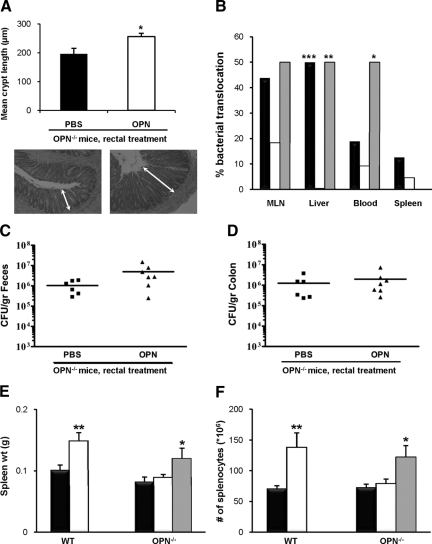Figure 4.
Rectal OPN restores responses to C. rodentium infection in OPN−/− mice. A: Quantification of colonic crypt length of OPN−/− mice receiving bovine milk OPN by daily rectal administration indicated a partial recovery in the phenotype with longer colonic crypts (N = 8 to 15; analysis of variance; *P = 0.01; representative micrographs below chart). B: Eighteen percent of infected OPN−/− mice (white bars) had bacterial translocation to the MLN, relative to 44% of infected wild-type (WT) mice (black bars; P = 0.09); translocation was restored in OPN−/− mice pretreated with rectal OPN (gray bars). Bacterial translocation to the liver was higher in wild-type and rectal OPN-treated mice than in infected OPN−/− mice (Fisher’s exact test: **P < 0.01 ***P < 0.0001), and bacteremia was more common in mice treated with rectal OPN (*P < 0.05). C and D: Fecal (C) and colonic (D) evidence of C. rodentium colonization was not increased in OPN−/− mice pretreated with rectal OPN (P = 0.09 and 0.5, respectively). E: An increase was observed in the weight of spleens from C. rodentium-infected wild-type mice (white bars in panels E and F), relative to uninfected wild-type mice (black bars; N = 12 and 8; analysis of variance: **P < 0.001). While infection of OPN−/− mice did not change the size of the spleen, topical rectal OPN given to OPN−/− mice infected with C. rodentium led to an increase in spleen weights (gray bars; N = 6; *P < 0.05). F: The number of splenocytes in wild-type mice doubled following C. rodentium infection (analysis of variance: **P < 0.01). There was no change in the splenocyte counts in OPN−/− mice in response to enteric infection, but the addition of daily rectal OPN to OPN−/− mice produced a response similar to levels seen in infected wild-type mice (*P < 0.05).

